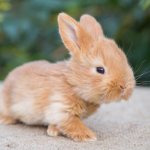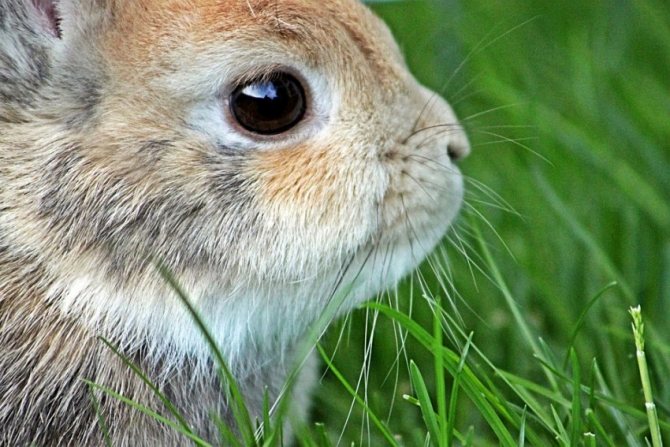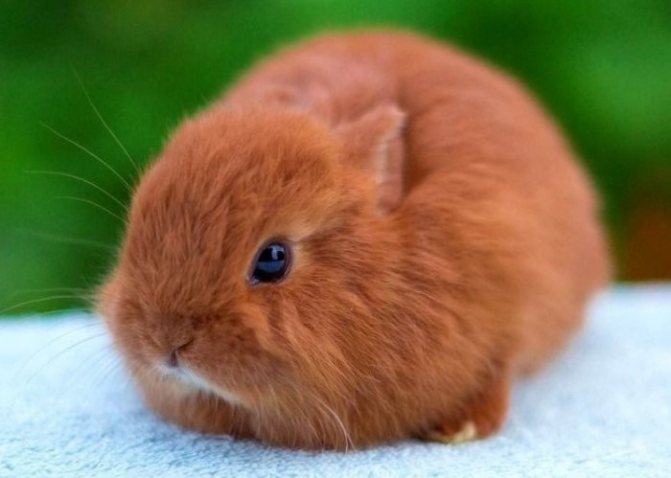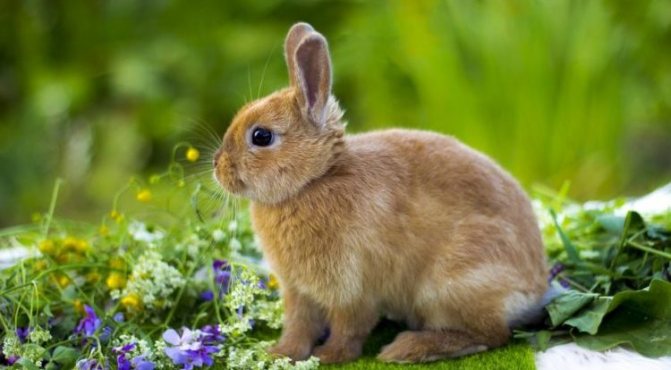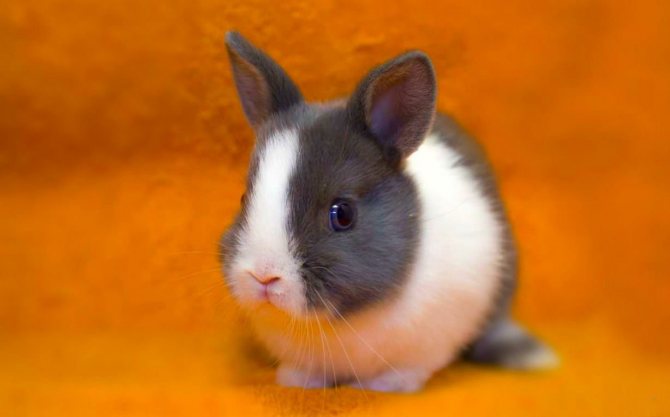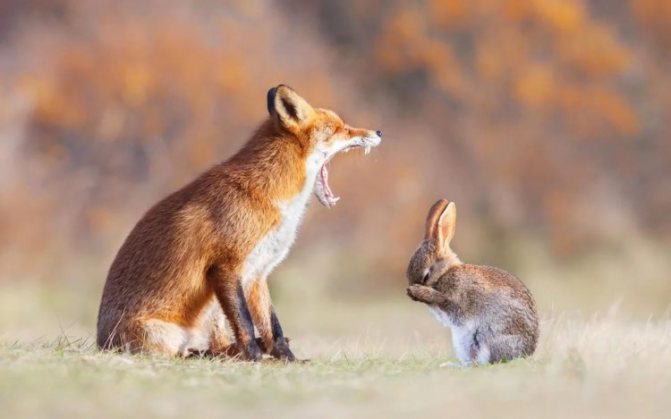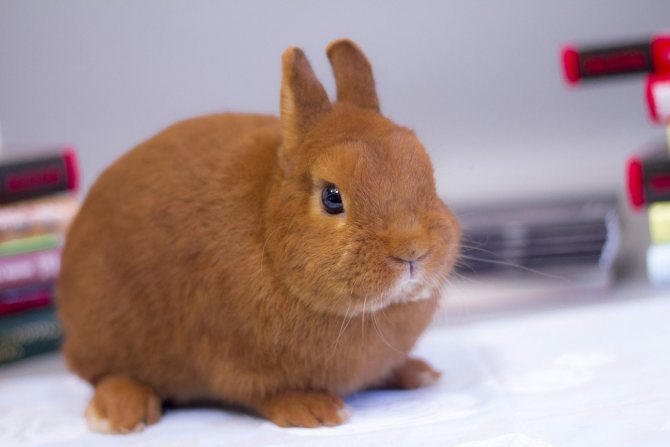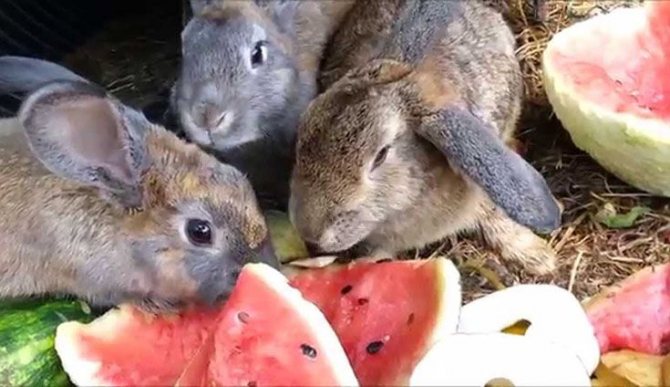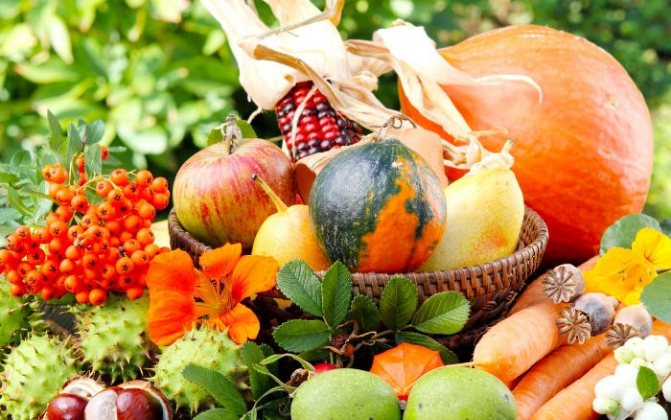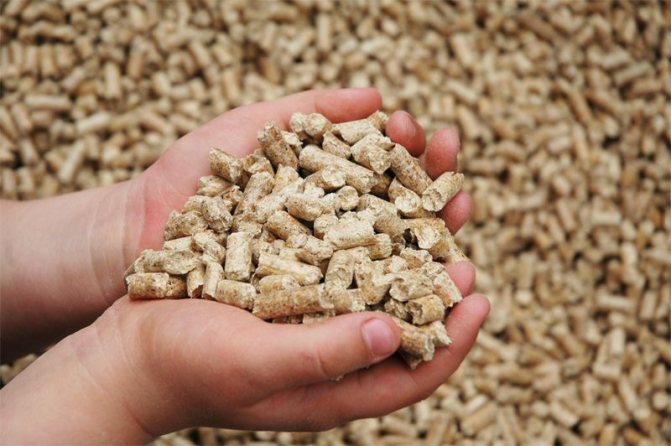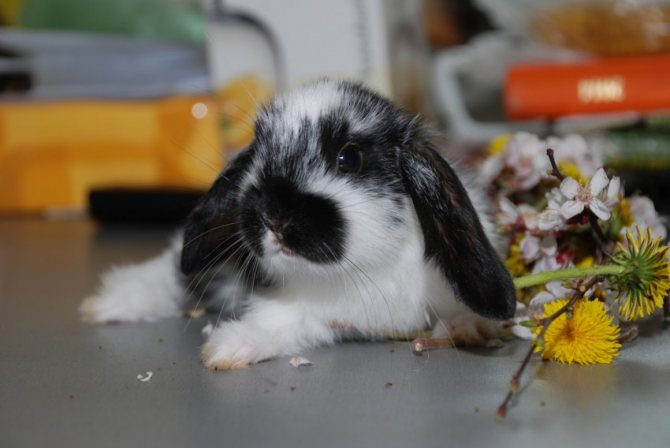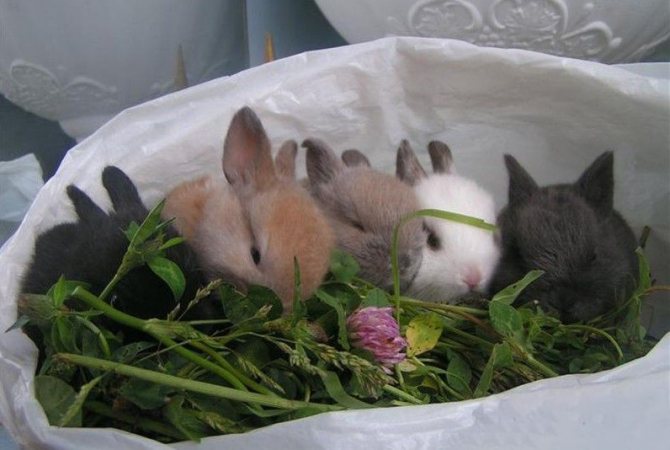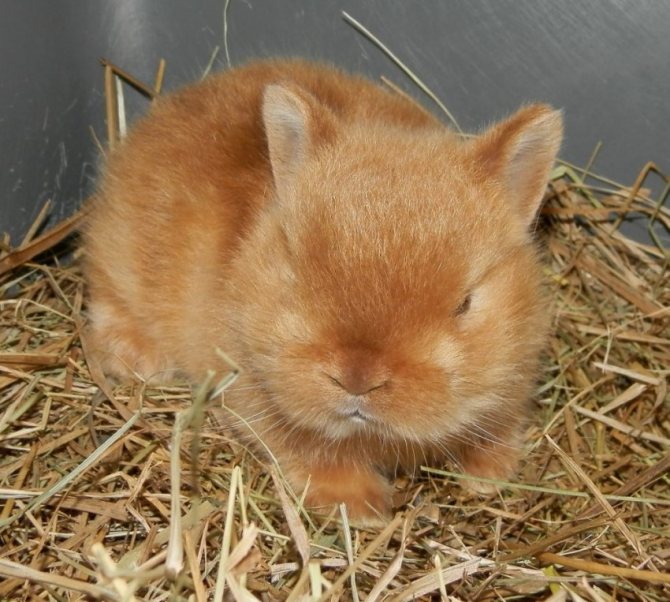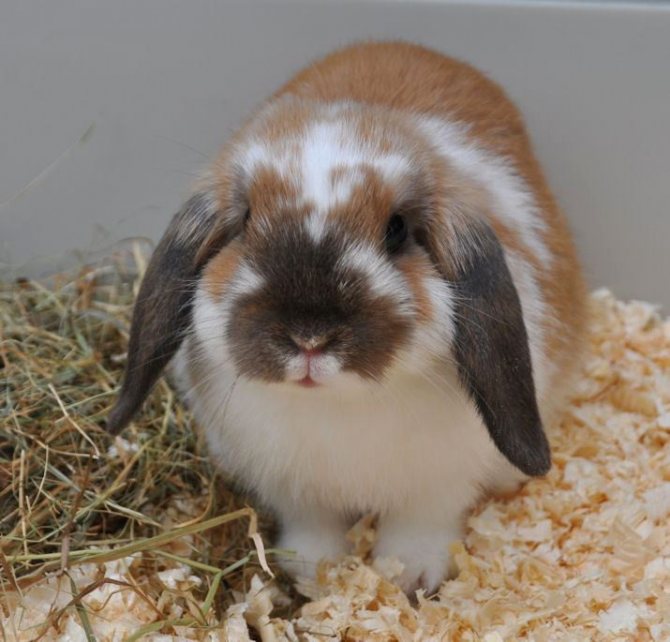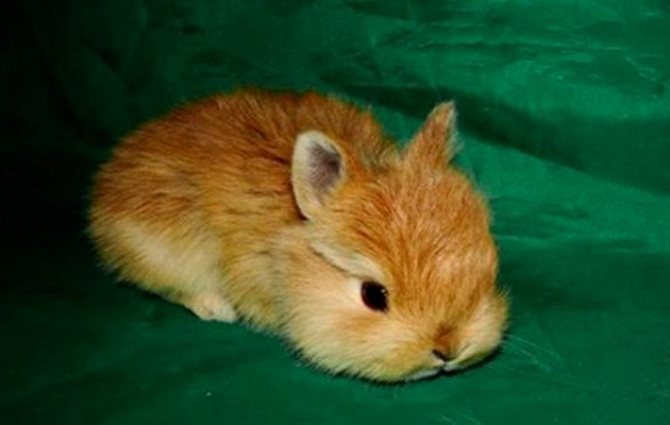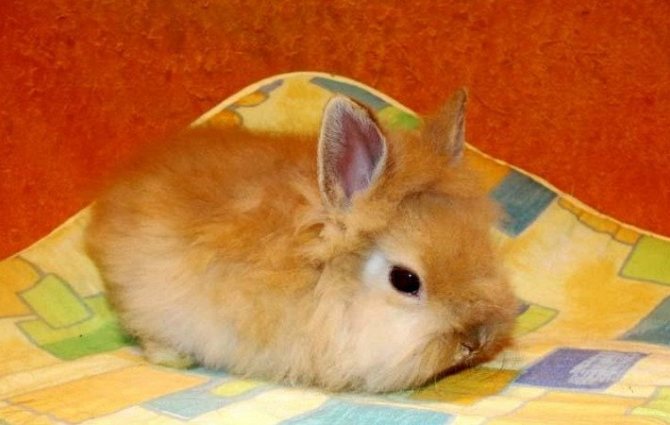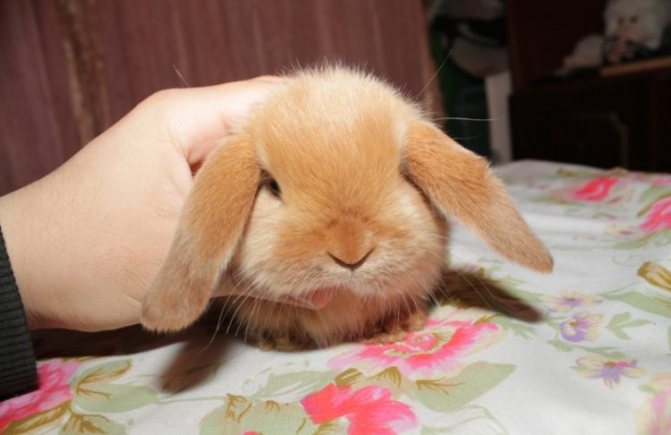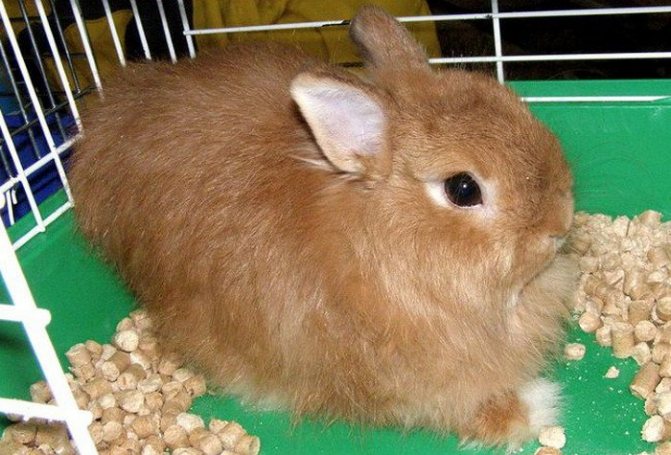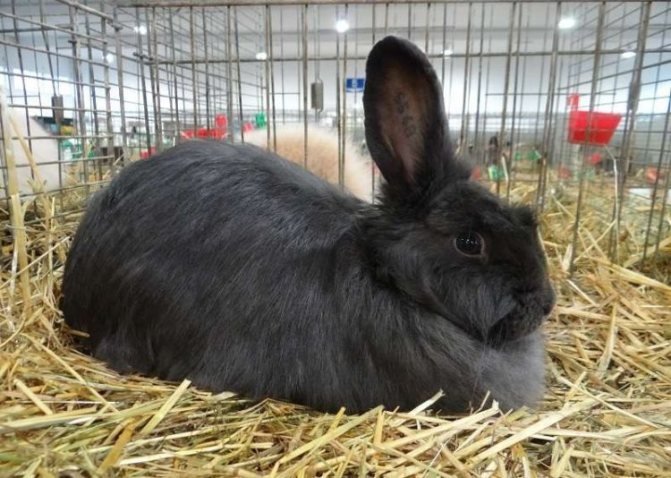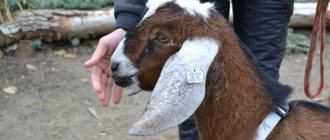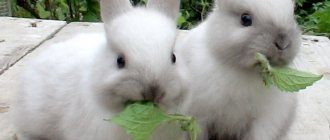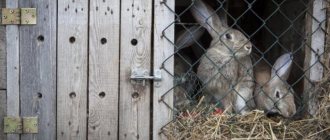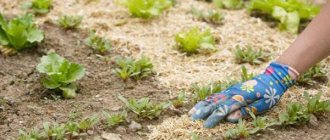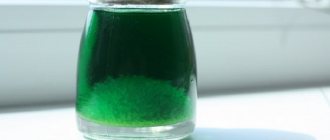If you want to have a small, cute, fluffy animal, then a dwarf rabbit is a great option. In order for the baby to feel good and not get sick, it is important to provide the necessary conditions for him and to provide proper care.
Origin
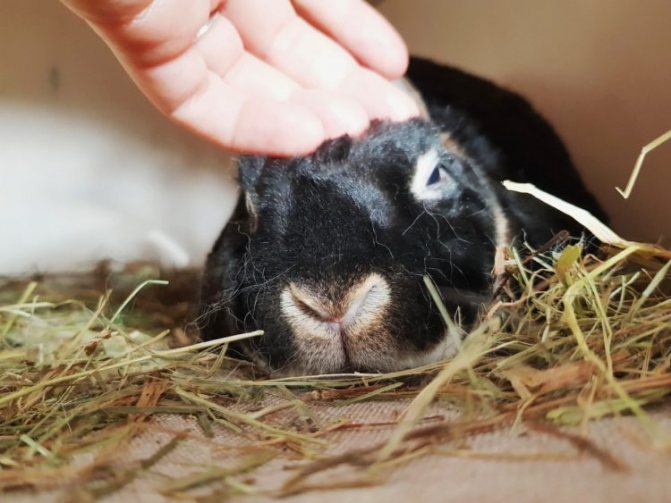
Gullible inhabitants were told that striped orange-black rabbits were originally from distant Japan and, more recently, frolicked in the personal zoo of the Japanese emperor himself. Soon, cute animals rose sharply in value, so for a long time they were kept only for decorative purposes.
Meticulous journalists found out that the breed was bred in Holland by local breeders. True, what breeds were used in breeding is still a mystery. The most common version among experts is the use of Danish tortoiseshell rabbits.
During the Second World War in the USA and Great Britain the breed became known as the Harlequin.
According to the American Rabbit Breeders Association (ARBA), this renaming was caused by the need to respect "the patriotic feelings of fellow citizens."
Taming and raising rabbits
Adult dwarf rabbits are quite intelligent animals. Proper training and education can make them real artists. When a pet appears in the house, it must first be tamed. Do not squeeze and carry the animal around. Let the baby first master the territory, get used to the new environment. To make him feel better, you need to give him something tasty. When the rabbit is eating, you can lightly pet it. It is possible to raise an animal only when it feels confident in a new place.
After the little rabbit has got used to it, you can proceed to further taming and training. The first step is to train your pet to the litter box. You do not need to put it right away. In the early days, track where the animal goes to the toilet. Then take some litter with excrement and place it in the litter box. Place a feeder next to the tray, rabbits often eat and empty at the same time. But you need to make sure that they do not stain the food.
Small decorative rabbits can be accustomed to their nickname. Take a treat in your hand and call your pet by name. First, he will go to the smell of food, and then he will develop a conditioned reflex to the nickname. In the same way, rabbits are taught to jump over a hoop or other obstacle. They put a treat on one side, and push the animal on the other. If the baby responds to the nickname, you can just call him.
Description of the breed
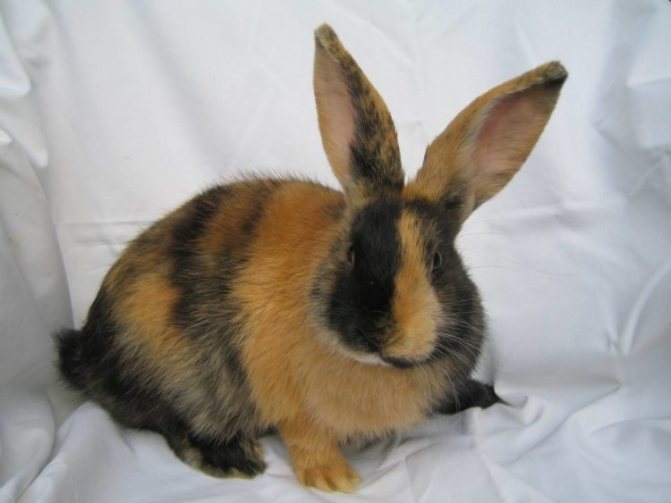

Dwarf animals of a variegated color look like a live toy. They become a real decoration of the house or household. Rabbits of this breed belong to the group of short-haired, since the length of their wool does not exceed 40 mm, and the length of downy hairs is 25 mm. The mass of adults is in the range of 800-1500 grams.
Reference. Interestingly, the Japanese rabbit was not bred in Japan at all, but in France. They were first presented at an animal show in 1887. The dwarf subspecies has all the features of a full-sized breed: the same checkerboard color from alternating stripes, a high degree of contrast in colors.
The dominant colors in the color of animals of the Japanese breed are yellow and black. In this case, there may be areas of ashy color, white and red.The clearer and brighter the stripes on the fur of an animal, the more closely it conforms to accepted standards and is valued most highly.
Species and subspecies of animals
Pannon the White Rabbit
On a note. Today there are already 60 breeds of mini rabbits.
Here is a brief description of some of the mini rabbit breeds:
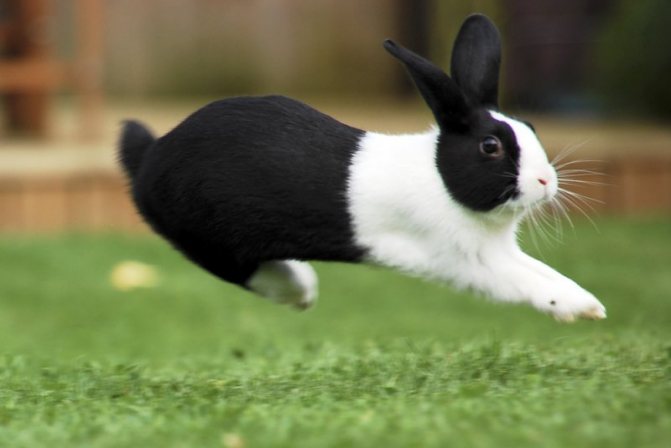

Dutch (Danish) rabbit
- The Dutch (Danish) rabbit is one of the world's ten most popular species of these fluffy animals. It stands out for its "gigantic" weight among its fellow tribesmen - it can weigh up to 2.5 kilograms. Differs in color, which matches the color of his eyes (black, less often brown or blue), as well as a white wedge on the nose and part of the body. Lives for almost ten years, lends itself well to training.
- The Dutch lop-eared ram confidently prevails among the dwarf breeds. Its distinctive feature is its long, up to 20 centimeters, ears. The color scheme of his coat includes almost all shades: from black to smoky. Having a large head, only half the size of the body, he resembles a plump hamster, good-natured and always chewing. But he gets along badly with domestic cats, dogs and other animals.
- Angora English dwarf resembles a lump of white fluff, because of which neither nose nor ears are visible. It barely weighs 1.5 kilograms, but there are exceptions. Its main advantage is down, which makes up 95% of its wool, the length of which is the same on all parts of the body. The fur color of angora mini rabbits can be varied. Some have a monochromatic coat: white, black or chocolate. There are individuals that alternate between red, black and white on woolen hairs (agouti). There are Angora dwarfs with spotted fur.
They are very calm, patient and not aggressive, which allows them to have them in a house with small children.
Important! Angora fluff can get tangled and roll, so it requires special care. Rabbits need to be combed often with a puff and cut out the rolled lumps that have appeared.
- With its special fur, the dwarf lion's head resembles the formidable king of animals, only in miniature. His whole body is covered with short hair, a lush mane grows on the head and straight ears, but the muzzle and eyes are free from long strands. It is small - it weighs no more than 1.7 kilograms. Some individuals may have a second mane, only on the sides and back. The character is a little timid, but friendly. The rabbit loves to jump high, so he needs a high aviary.
- Another representative of the wild animal world - the fox dwarf rabbit, bears great resemblance to foxes in a reduced form. The head is pointed towards the nose. The coat color of rabbits is bright red. The size of the front legs is half the size of the hind legs. Erect ears, rounded at the tips, reach 5-7 centimeters. They can weigh from one kilogram to one and a half.
- Another representatives of the miniature rabbit breed - colored dwarfs, were bred in Holland. These tiny cute rodents with a bright red coat and short ears can be aggressive, especially during puberty. Therefore, for home maintenance, they need cells so that they do not come into contact with children. Their weight ranges from 800 grams to 1.5 kilograms. Up to 60 color shades and combinations of their wool are officially registered.
- Dwarf Rex are the owners of the most beautiful velvety coat, with up to 19 colors. They were brought out by one French priest. They live only 5-6 years, although they have good health. They are friendly and non-aggressive. In terms of the quality of the fur, the Japanese rabbit can be attributed to the Rex group. Its fur skin resembles silk, its appearance is a plush stuffed toy. The color is ash, red or white with spots or stripes. The Japanese dwarf usually weighs 800-1500 grams. It was also bred in France.
- A very rare species of satin (satin) mini rabbits with very short, smooth fur has a distinctive feature - the color of their eyes matches the shade of the coat. Red-eyed dwarfs are found, but very rare. They are calm, even a little lazy.
This list can be enumerated endlessly, because each breed is unique, although it has its own subspecies.
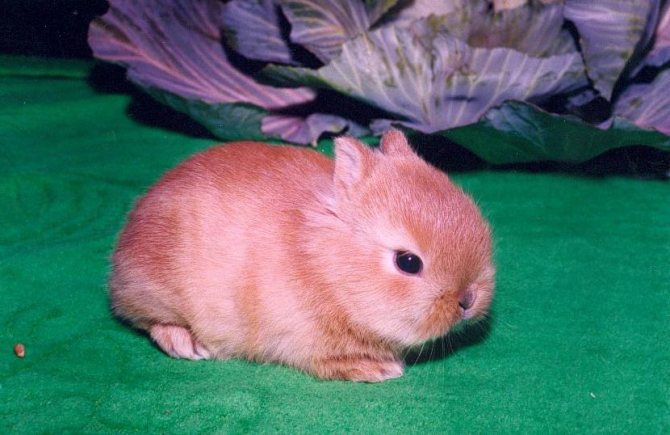

There are 60 breeds of mini rabbits
Breed selection
Currently, according to the European standard, there are 5 breeds of dwarf rabbits: hermelin (ermine), colored dwarfs, dwarf lop-eared - "rams", short-haired - rex and long-haired "fox".
Polish rabbit
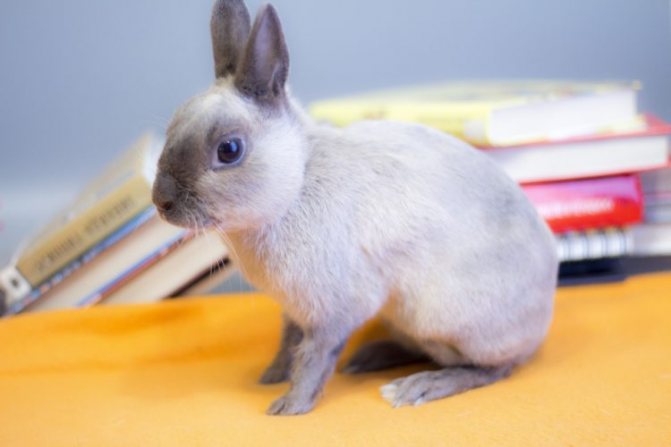

The Polish rabbit comes in only one color: white. Red-eyed rabbits of English origin appeared in the second half of the 19th century. Blue-eyed were bred in Germany around 1920. Between 1875 and 1900, Polish rabbits appeared frequently in British exhibitions and were bred quite intensively. Then they looked somewhat different from their modern counterparts. They were larger and longer, they did not have the characteristic spherical head, like their descendants. On the contrary, their heads were rather small. Polish rabbits are the result of crossing wild rabbits, Dutch, albino little silver rabbits. Around the beginning of the 20th century, the first red-eyed Polish rabbits appeared in Europe. In Germany and Holland, they were very popular due to their friendly disposition. The red-eyed Polish rabbit was recognized as a breed in 1907, and the blue-eyed in 1927. The red-eyed Polish rabbit is more common.
Japanese dwarf rabbit
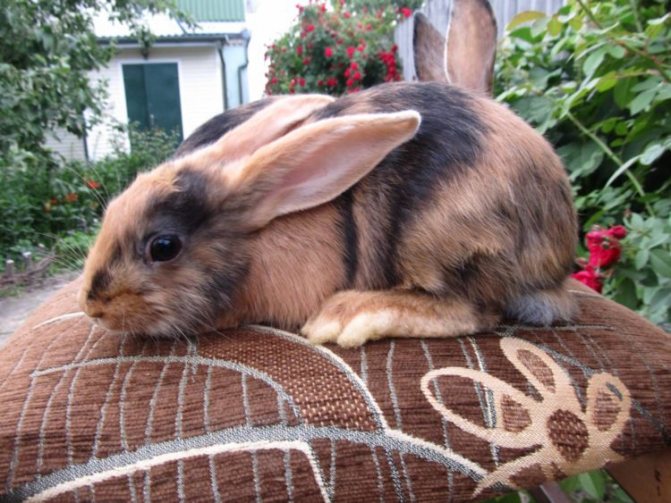

A breed with a beautiful, but difficult to maintain color. This color is more or less symmetrical with dark and yellowish stripes all over the body. The right side should be dark, the left yellowish and vice versa. The border of flowers runs exactly in the middle of the back. The pinnacle of rabbit breeding is a rabbit with a dark ear on the yellowish side of the muzzle and vice versa.
Dutch pygmy ram
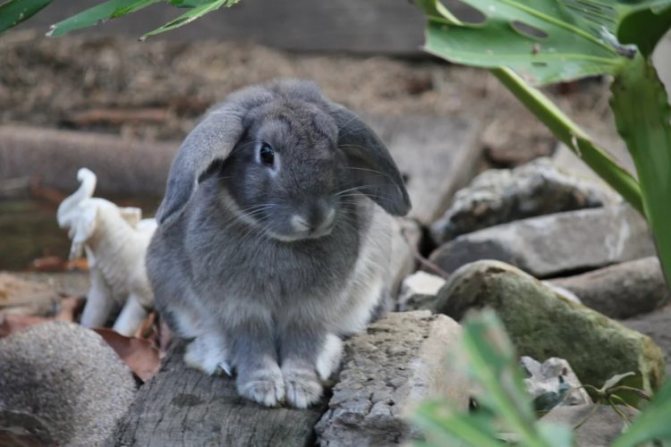

The Dutch pygmy ram deserves a separate consideration. It appeared in Holland in 1950-1960 thanks to the efforts of the famous rabbit breeder from Tilburg Andriaan de Kok. Never before has a new breed become so popular. This is a miniature copy of a large French ram. His body is short and strong, his chest is wide, there is practically no neck. The back line extends from the neck to the tail, slightly curving. Feet are short and strong. The head is broad (especially between the eyes) and fairly well developed, as are the cheeks and muzzle. Ears hanging down are highlighted. They are approximately 22-27 cm long when measured across the head from the base of one ear to the other. The breed can be of various colors. The most famous are variegated and Madagascar. There are also light gray, dull gray, lilac, bluish gray, black, blue, isabella, marten colors and other colors. Now more and more new colors appear. Just like the Polish rabbit and the colored dwarf rabbits, the Dutch dwarf ram has a friendly personality, so it is very suitable for children. Its weight can reach from 1250 to 1650 g.
Dwarf dutch rabbit
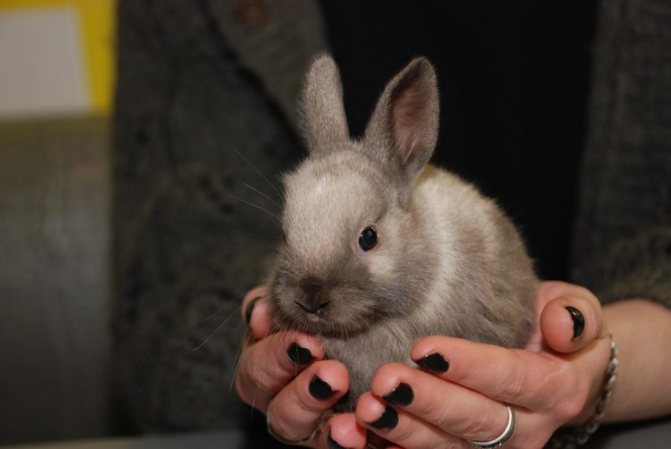

A complete copy of its large relative: colored circles around the eyes, colored ears and the back of the body. The rest of the body is white. White socks on the hind legs. There are rabbits of the following colors: light gray, lilac, black, brown and blue.
From the history of dwarf breeding
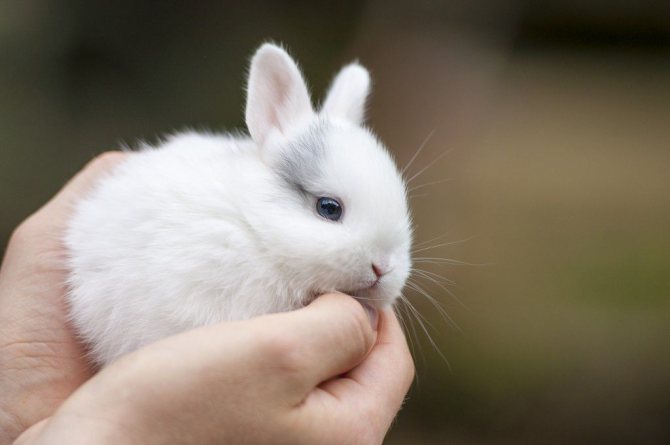

The decorative rabbit differs little from the dwarf
To breed a new species, scientists used a silvery little rabbit, the genes of which provided the offspring with small sizes. As a result of breeding research in 1870, a breed was shown and registered at the exhibition, which was named the Polish white downy mini rabbit (Britannia petit).Continuing their work, in 1920 German scientists presented a completely new breed of dwarf curly rabbit - Hermelin. They were united by the presence of the dwarf gene in the DNA, and not just small size. Ten years later, in Holland, they received multi-colored mini rabbits. Only in 1940 was a single standard for a dwarf breed approved.
On a note. In order not to be mistaken in the choice and not to confuse mini rabbits with decorative tribesmen, it is necessary to require a certificate when purchasing. The decorative rabbit differs little from the dwarf.
There is another way to choose the right miniature animal: show its parents.
Today, 15 species of dwarf rabbit breeds are officially registered, but they also have their own subspecies and mestizos. Unofficial data indicate that about 200 breeds have already been bred in the world, including almost seventy in Russia. All of them differ in color (having two or three colors and more than 60 shades), in fur (short and long, curly, velvety and downy), in the shape and length of the ears (erect and drooping, with sizes from 6 to 20 centimeters), by weight (from 1.7 to 3 kilograms) and proportions.
Interesting. The lion-headed dwarf was bred at the beginning of the new century, the authorship of its creation caused controversy between the breeders of America and Belgium. In any case, this breed is the newest. The smallest of the dwarfs is the minor breed, although it is not officially recognized.
We feed correctly
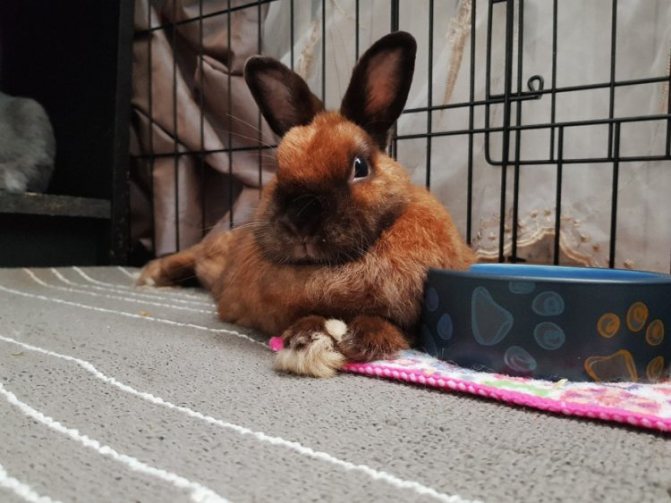

The dwarf rabbit is quite unpretentious in nutrition, but still requires a varied diet. In addition to the special concentrate, the diet should contain:
- vegetables: carrots, beets, cabbage;
- fruits: watermelon, apple, pear;
- herbs: dandelion, alfalfa, vetch, burdock, plantain, yarrow, ivan tea, mouse peas, silage;
- cereals and legumes: oats, peas, wheat.
There must be sufficient water, clean and fresh. Also, dwarf rabbits should always be able to eat hay. Up to 6 months old, alfalfa hay is best for them, but oatmeal hay is ideal for older babies. Hay must be dry, fresh, without rot and mold.
Avoid feeding rabbits foods that cause digestive problems.:
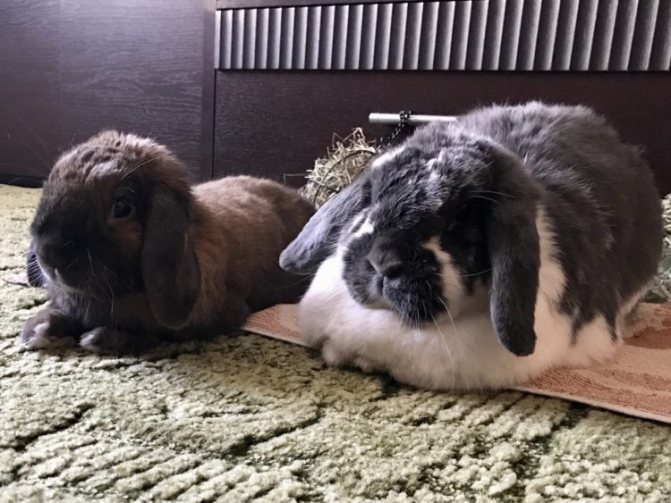

- milk and dairy products;
- leftovers from the table;
- beans, red cabbage;
- henbane, dope, hemlock, lily of the valley.
General recommendations for the condition of the feed are freshness of food, maturity, no spoilage, mold, rot or debate. In no case should rabbits be fed wet food! How long the pet will live - 1 year or 12 years - it all depends on your care and attention. Remember that you are buying an animal, not just a stuffed animal.
Appearance
The long, drooping coat of dwarf fox rabbits can reach 3.5-7 cm. Fur villi are strong and thick. Due to this, the animal looks very fluffy and attractive. Rabbits of the "fox" breed have a strong stocky constitution with a small neck and an enlarged head. The short, rounded ears always stick up. The animal has short front legs and a compact tail, tightly pressed to the body.
In addition to the red "fox" color, the breed standard includes black, blue, white and chinchilla suits, as well as the color of Havana. Rabbit eyes can have a red or blue tint.
Breed standard approved in 1997:
- weight - 1-1.5 kg;
- head width - 55 mm (males), 50 mm (females);
- lack of dewlap;
- ear length - up to 55 mm.
Purebred fox rabbits are bred exclusively in their own color: white representatives are crossed only with white ones, red ones - with red ones. The most valuable are animals of white color and Havana.
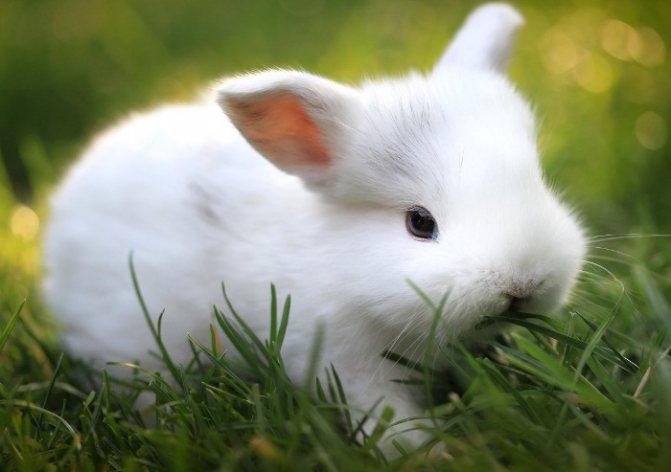

Rabbit dwarf fox white color
Keeping dwarf rabbits
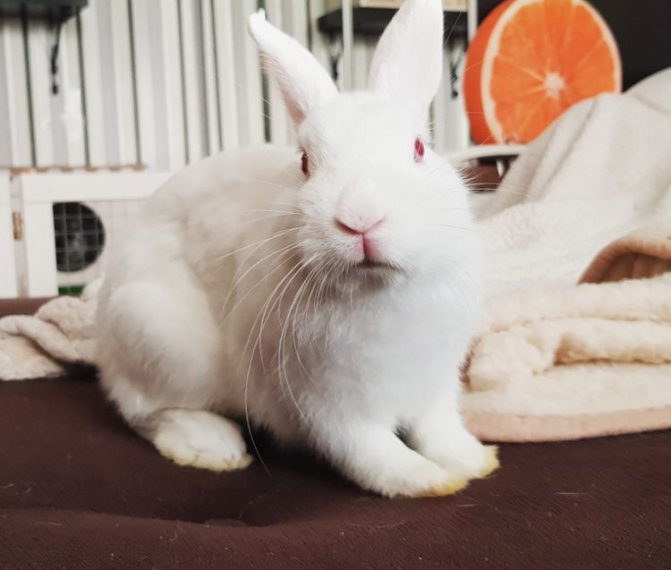

Keeping dwarf rabbits at home is becoming more and more popular.Caring for them is simple, and the animals take up very little space. Before you buy a dwarf rabbit, you should take care of the following things:
- Purchase a cage at least 40 × 70 cm in size, or an aviary 1 × 1 m
- Make a small litter box or buy a cat
- Equip feeders and drinkers in a cage or aviary
- Come up with a bedding, straw or sawdust is suitable for this
- Think over a place for walking, remove wires, small objects from the room
- If you vaccinate a rabbit, you can walk with it on the street, for this you need a leash with a harness
Rabbits are clean animals, the cage and aviary should be cleaned at least once a week. The litter is completely changed or only the top layer is removed. If there is a litter box in the rabbit dwelling, it needs to be changed 2-3 times a week, and the bedding can be cleaned once every 2 weeks. In the room where the pet is walking, all small objects should be removed. The cage is placed away from the window and heating appliances. Fluffy animals do not like overheating and drafts.
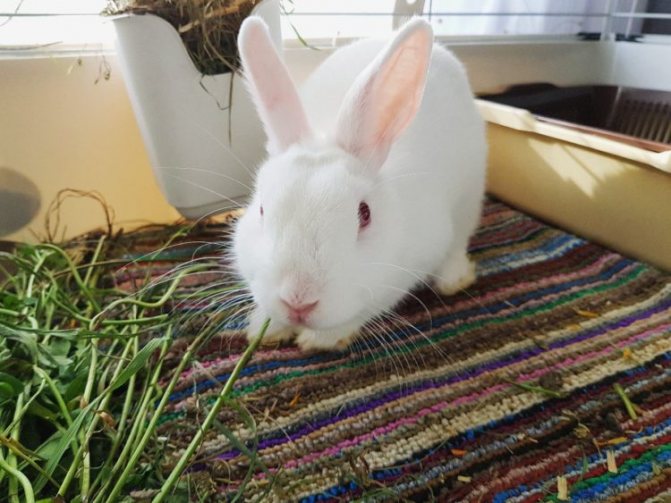

If you plan to keep the dwarf rabbit in an aviary, set it up in a corner, away from windows and doors. It is good to put there a manger for hay, feeders, a tray, ladders, a wheel. When keeping a rabbit in an open-air cage, you may not be allowed to walk around the room. Some owners put their cages on the street or on the balcony. It is important that direct sunlight does not fall on them, otherwise the animal will overheat. You can keep your pet outdoors only in warm weather. Taking proper care of dwarf rabbits will greatly increase their lifespan. Therefore, you should not ignore even the simplest rules.
Care and hygiene
It is necessary to clean the cage as needed, on average they do it 3 times a month. Drinking bowls and feeders are boiled once a week. The litter is changed as it gets dirty, it all depends on what it consists of.
Everyone who is familiar with decorative dwarf rabbits knows that these are fairly clean animals. Based on this, there is no need to specially bathe them. The exceptions are cases of diarrhea and intense heat.
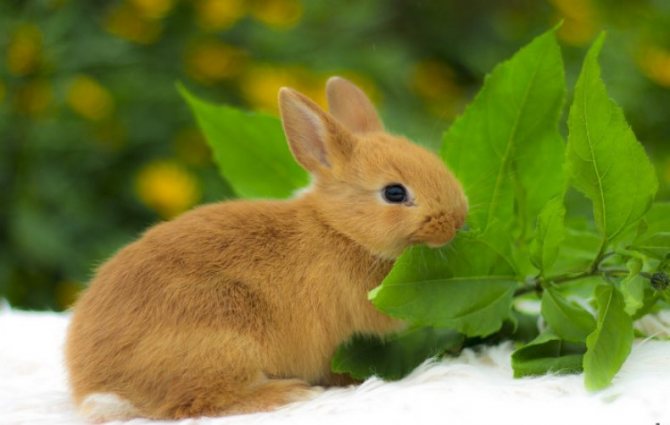

For this procedure, it is recommended to use a high quality pet shampoo, the properties of which will have a good effect on the quality of the wool. After washing, the wool is dried and combed out. Also, caring for a rabbit consists of cleaning the ears and eyes and trimming the claws.
Reproduction
Breeding miniature breeds at home is no different from breeding large varieties. Females are fertile, they bring 10-15 cubs in one round. They give birth 6-9 times a year. Males and females mature at 3.5-4 months, but the optimal period for mating is 4-5 months. The most suitable for breeding is the colored species, Dutch, Polish hermelin, Japanese, lop-eared ram.
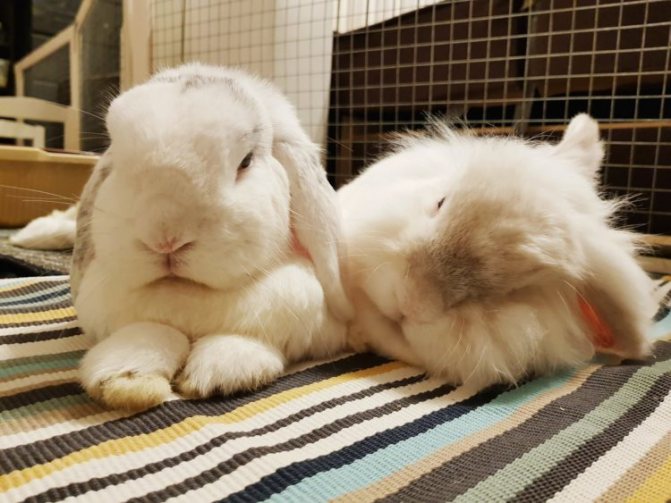

If a person is interested in breeding dwarf rabbits, it is worth choosing purebred animals of a certain breed. So it will be possible to quickly find buyers for the offspring. It is better to look for animals in nurseries that issue documents.
The male and female are kept separately, a few days before the intended mating, the cages are placed side by side so that the animals get used to each other. The girl is always put next to the boy, because he feels more confident in his own territory. The couple is kept together from 3-4 days to two weeks. Before the birth, the female must be seated, the male is able to eat newborn rabbits. During mating, be sure to monitor whether the animals get along well with each other, whether they are not making fights. If conflicts arise between them, the animals are immediately resettled, breeding will not be successful.
The duration of pregnancy in a female is 25-30 days. During this time, she is fed a high protein meal. The diet includes oats, legumes, meat and bone meal.It is worth buying special protein and vitamin supplements for pregnant rabbits at a veterinary pharmacy or pet store.
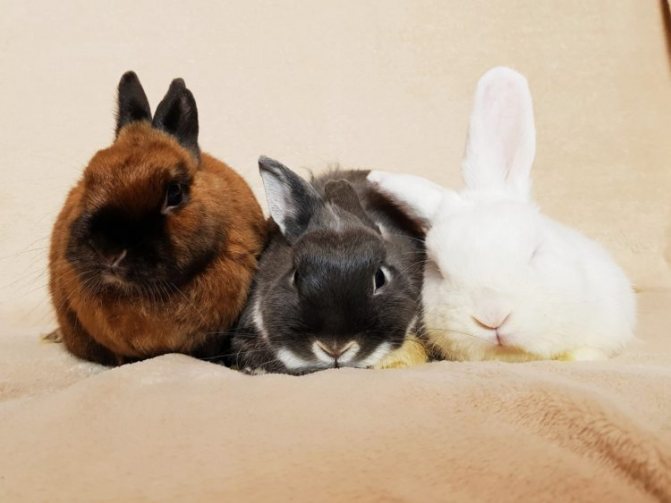

Before the birth of cubs, the female becomes restless, begins to build a nest. A dwarf bunny is born blind and hairless. In the early days, it is better not to touch the babies, their mother is able to get scared and stop feeding.
Cubs quickly gain weight, already at the end of the first week of life they become twice as large, and at 3 months dwarf rabbits weigh the same as adults. There is almost no need to look after the babies, the female copes well with everything herself.
Breastfeeding lasts 35-45 days. It is better to wean the cubs from the female at 2 months. They are placed in a separate cage. It is imperative to distinguish where the females are and where the males are. From 2.5-3 months, the rabbits must live separately, because puberty begins. After giving birth, the female develops a heat in 2-3 days, she is ready for a new fertilization. Do not put her next to the male until the end of feeding. so that the rabbit is not exhausted, she cannot give birth more than 4-5 times a year.
Rabbits with soft "fox" hair
For the first time, they started talking about rabbits of the fox breed in the 20s of the last century, when breeders from Switzerland presented decorative animals with long soft hair, reminiscent of a fox in structure.
These animals, weighing 4 kg, were classified as decorative breeds. For many years they have been bred for beautiful skins and dietetic meats. The skins of the fox rabbits were white, black and blue. Used for sewing fur coats, hats and other fur products.
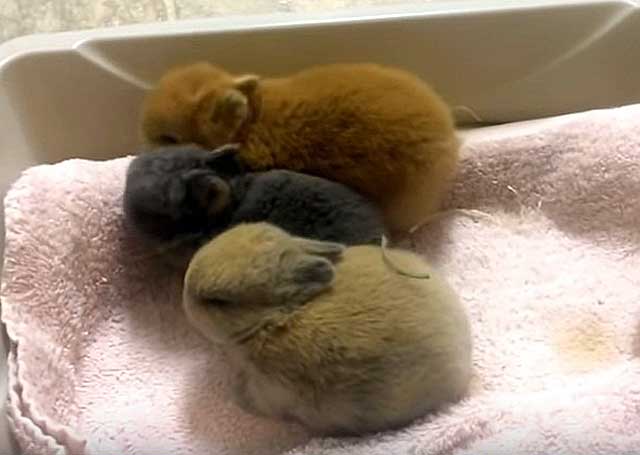

Around the same years, a meat breed of silver fox rabbits with a muscular body and reaching a weight of 5 kilograms or more was bred in the United States. These hardy animals adapt easily to life in all conditions, are prolific and gain weight quickly, and their breeding is very profitable.
As the animal rights movement gained momentum in the middle of the 20th century, the demand for the skins of the Swiss fox rabbits fell sharply and the breed began to gradually degenerate.
However, in 1992, a group of enthusiasts from Austria introduced the dwarf fox breed to the general public. This fluffy eared ears were much smaller, consumed less feed, and easily adapted to life in a residential building or apartment in a multi-storey building.
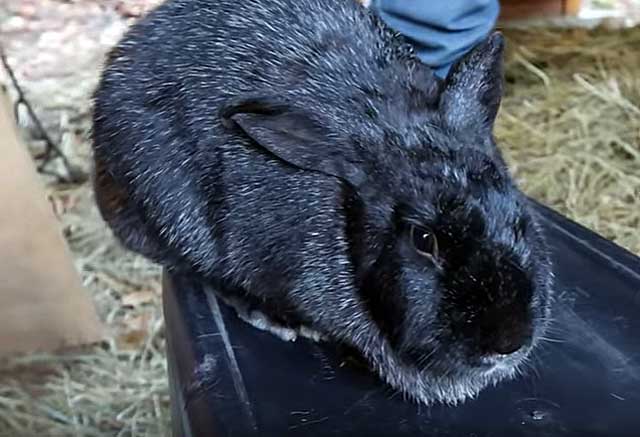

Diseases and treatment
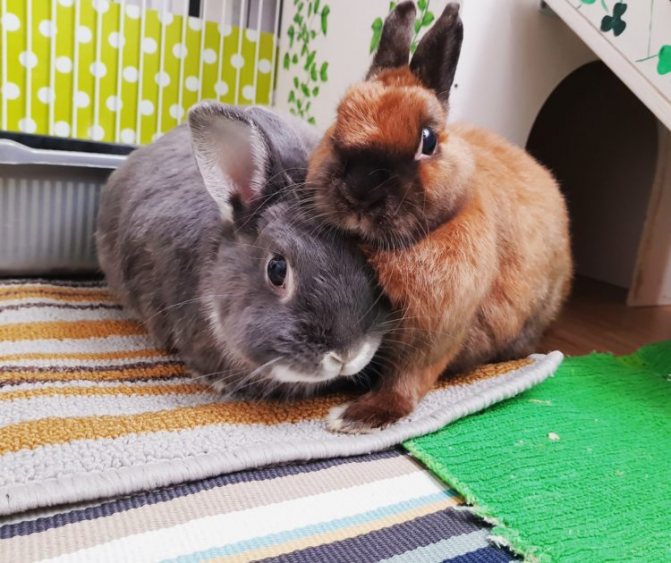

Vaccines and vaccinations for dwarf rabbits are essential. These gentle creatures, even in comfortable room conditions, can catch a disease such as a cold or conjunctivitis. Both hypothermia and heatstroke are equally dangerous for them. Timely vaccinations will protect the young rabbits from infections and dangerous diseases such as rabies.
Therefore, the condition of the pets must be monitored constantly. The following symptoms can indicate the disease:
- Vomiting, nausea, bloating.
- Loose stools or constipation.
- Belching, rumbling in the stomach, bad breath.
- Fatigue, lethargy, drowsiness.
Even if there are one or two symptoms, the baby should be shown to the veterinarian: delay can be disastrous for him.
Rabbits are afraid of overheating and hypothermia
Because animals are curious, it is best to place the cage on a coffee table, allowing the rabbits to explore the apartment.
From time to time they need to be released for a walk, making sure that the rabbits are not in a draft, and also do not overheat.
The optimum temperature in the room where rabbits are kept should be 18-20 degrees Celsius. This will reliably protect the animals from overheating and heatstroke. For the same reason, it is not recommended to hold long-eared pets in your arms.
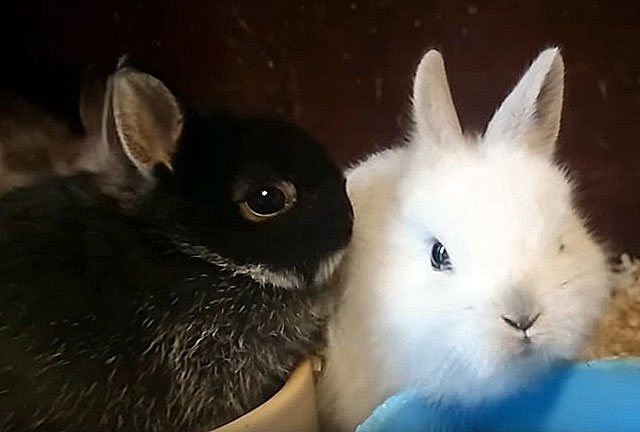

In hot weather, it is recommended to put a plastic bottle with ice in the cage, which will cool the air and prevent overheating of these long-haired animals.
You can also periodically wipe it with a wet cloth behind the ears of the rabbit, although you can only bathe the animal in exceptional cases. This is due to the fact that when the water evaporates, the animal is greatly supercooled and can get sick. And in some cases, this procedure is fatal.
How to choose a rabbit?
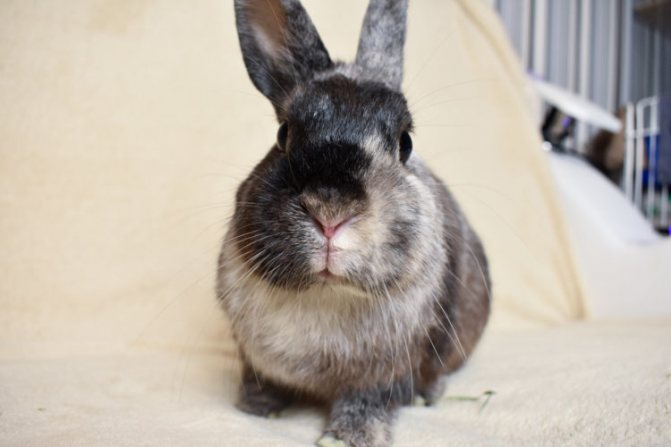

Dwarf rabbits must be healthy. This is a prerequisite that should not be forgotten during the purchase.
You should familiarize yourself with some recommendations that will help determine the condition of the pet:
- The coat should be smooth and silky. Bald patches can be a sign of disease.
- Take a closer look at your nose, eyes, and anus. There should be no moisture, mats or bruises around them.
- A healthy rabbit has clean breathing. There should be no smells, wheezing.
- Watch your pet's movement. He should not limp, be afraid of anything, feel constrained.
- Character can play an important role. Decorative rabbits should show calmness, adequacy. Excessive agitation, phlegm can serve as a sign of the disease.
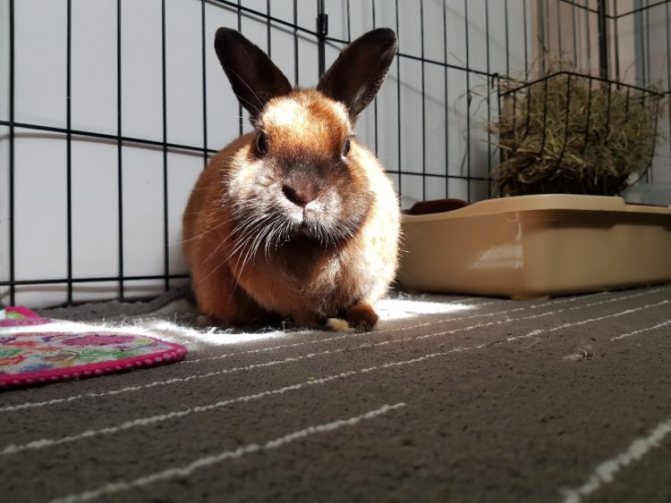

When considering different breeds of dwarf rabbits, remember that you need to make a choice in favor of any one animal. For this reason, before buying, familiarize yourself with the characteristics inherent in each type of animal. Find out how many years they live, learn how to care for them and what to feed them.
What to feed and how to drink
Everyone knows that rabbits eat often, they can go to food up to 30 times a day. Food must always be available directly.
The main diet of rabbits of this breed consists of the following products:
- fresh grass;
- hay;
- compound feed;
- cereals;
- vegetables and fruits;
- mineral stone, chalk and bone meal.
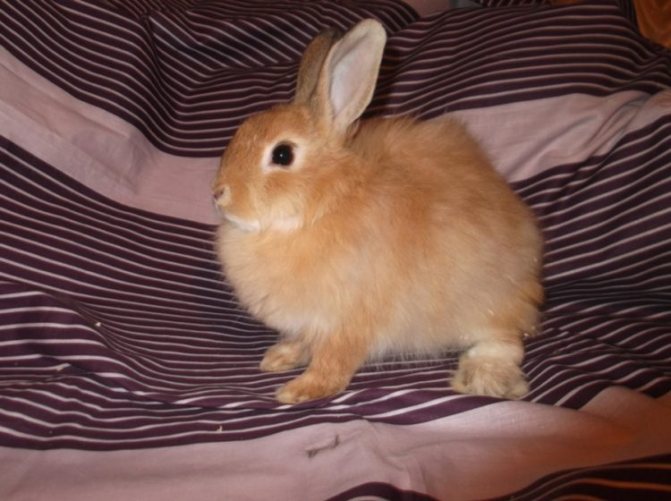

It is important to let them gnaw on hard twigs to grind off teeth that grow throughout their lives.
It is forbidden to give to these animals:
- red cabbage;
- ground grain;
- white cabbage should be limited.
At the same time, it is important that clean water is always present in the drinker.
Compliance with all the rules of care will allow your pet to live for about 7 years. For health, they need walks not only around the apartment, but also in the fresh air. Remember that the quality of their life is influenced by the external environment, balanced nutrition and sanitation, and then your pet will only delight you with its presence.
Experienced advice
If the mini rabbit does not eat hay, moisten it with salted water. Fluffy rodents need bone meal and chalk, as well as oats and wheat. Another important point is that they sometimes eat their digested waste. It is absolutely harmless to rabbits.
There is a lot of information on how to care for dwarf rabbits, both in popular science literature and on the Internet. A description of the characteristics of the breeds, how to choose them will help determine which mini rabbit is better to take. The advice of experienced breeders will help you create the right home care. Loving and taking care of your pet will become the main goal of the whole family: both adults and children.
Video
Proper nutrition with fresh feed
Just like representatives of other breeds, dwarf foxes are very fond of eating green grass and fresh hay. Due to the fact that their teeth are constantly growing, animals should be given harsh food that they will chew on. Young twigs of viburnum, raspberry, apple, linden, birch or mountain ash are perfect for this.
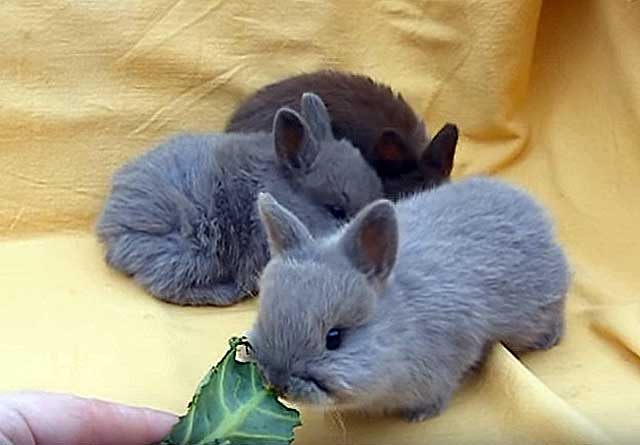

Dwarf fox rabbits happily eat cobs of corn, carrots, apples and boiled potatoes, as well as oats, wheat and barley.
When collecting fresh grass, make sure that toxic plants (euphorbia, lily of the valley, celandine, henbane and datura) do not get into the cage, which will definitely lead to poisoning of your pet.
Remember that overeating for rabbits is just as dangerous as a lack of appetite. This can lead to intestinal obstruction, bloating and subsequent death of the animal. Therefore, try to examine your fox pets daily, revealing even the slightest health problems in them.
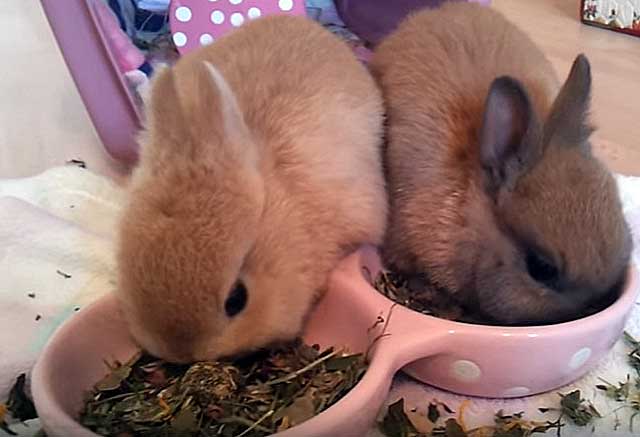

With proper care, dwarf fox rabbits live for at least 5-7 years, and some individuals can delight you even longer.
Get to know another dwarf breed in the article “About the Dutch rabbits”.
Post a class if the article was interesting and useful to you.
Tell us in the comments about your experience with dwarf fox rabbits.
Rabbit care
Caring for a dwarf domestic rabbit is simple. But he is a living being, which means he needs time and attention. Some people think that rabbits smell bad. This happens if the cage and tray are not cleaned in time. The aviary is cleaned every seven days, the tray is changed 2-3 times a week. The closed rabbit cage should be cleaned more often, once every 3-4 days. Smell problems arise if a male lives in the house. His urine really stinks badly. For this "boys" are castrated at an early age. They become calm, do not fight, and the smell of marks disappears.
Every day, the rabbit must be walked in the apartment. At the same time, they make sure that small objects, wires and cables, and other things that he wants to gnaw do not fall into the path of the animal. It is best to fence the place for a walk with a barrier or net. It is worth playing with a rabbit in the evenings, during the day the animals sleep, you do not need to touch them. The rabbits are also taken out onto the street. They buy a special harness for walking.
Feeding
It is important to feed the dwarf rabbit properly, otherwise it will get sick and will need treatment from a veterinarian. The main food of the animal is hay. It is harvested in the summer on its own or bought at a pet store. Hay is chosen fresh, fragrant, without signs of decay and mold. If the animal does not want to eat dry grass, it is slightly moistened with salted water or sprinkled with flour.
Dwarf rabbits eat other foods:
- fresh grass;
- grain (barley, oats, wheat);
- corn cobs;
- boiled potatoes;
- raw or boiled carrots, turnips;
- sugar or fodder beets;
- cabbage;
- apples;
- chalk, special salt stone or meat and bone meal.
Pet stores sell special pellets that contain the entire list of essential vitamins and minerals. They are given in the evening, 2-3 spoons per individual. Fresh herbs and vegetables should not be given in large quantities. It is better to pamper your pet with such food 3-4 times a week. From a large amount of cabbage, animals swell. Animals should not be given sweets, dried fruits, sugar beets, it is advisable not to feed cauliflower, otherwise intestinal diseases will have to be treated.
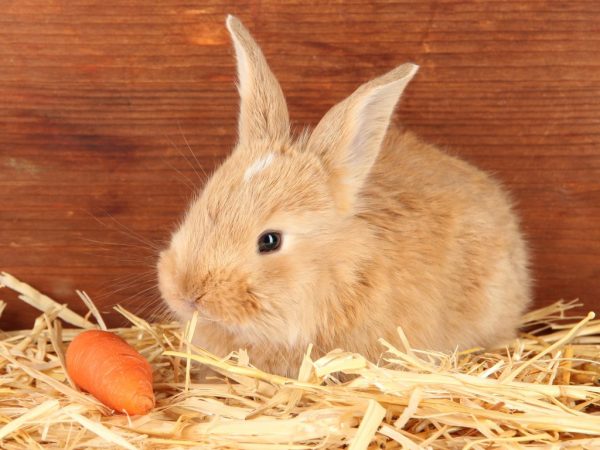

The diet of animals should contain a large amount of vegetables (cucumbers, radishes, carrots), dried fruits (bananas, raisins, dried apricots), green leaves and fresh hay
The animal eats 20-30 times a day. He has a small stomach and a fast metabolism. Access to food must be constant. Hay should be kept in the manger around the clock. Wet mash must be cleaned on time so that they do not deteriorate. It is good to train your pet to eat at certain times. Requires 24/7 access to water. It is better to buy an automatic drinker so that the dwarf animal does not turn the bowl over.
We suggest you familiarize yourself with: Decorative Angora rabbit knitting
We told you how to care for a dwarf rabbit. Now let's talk about feeding. What can dwarf rabbits eat? These are herbivorous animals, therefore the basis of the diet is hay or fresh grass. They should always be in a cage or aviary. The stomach of dwarf breeds is small, they eat often (almost all the time), in small portions.
In addition to herbs, the diet includes juicy food - carrots, boiled potatoes, cucumber peelings, cabbage leaves, watermelon peels.Red beets are contraindicated in rabbits. Potatoes can be boiled in salted water. Rabbits can be given fruits - apples, strawberries, pears. For the winter, dried fruits are harvested, which the animals eat with pleasure. It is important to know how much fruit you can feed your rabbit. It is best to treat him with such food 2-3 times a week, in the amount of 10-15 grams.
Also, the animals need to be given grain. You can feed special food for dwarf rabbits, consisting of various grains, dried fruits with hay additives. If this is not possible, make a mixture of oats, wheat, corn and barley in equal parts. So that pets can sharpen their teeth at home, they are given twigs, animals eat rowan, birch, maple, willow, oak. For the prevention of vitamin deficiency in winter, spruce or pine branches are useful.
Be sure to include mineral supplements in the diet. Calcium is very important for rabbits. With its deficiency, such dangerous symptoms as convulsions, heart failure appear, little rabbits can even die from this. To make up for the deficiency, the animals are given bone meal, chalk or special preparations.
Site preparation
If a miniature stick-eared animal appears in the house, it is worth preparing a place for it. It should be located at a great distance from the battery and air conditioner. Animals do not tolerate heat, drafts and direct sunlight. The dwelling is installed in the shade in that part of the room that is not blown out during ventilation.
Keeping dwarf rabbits at home can be cage or aviary. The first option is suitable for a small apartment. The cages must meet the following requirements:
- All parts of the cage should be made of special durable plastic or metal so that the animal does not chew them.
- A dwarf domestic rabbit and the length of the cage should be proportionate, the house is chosen 4-5 times the size of the pet.
- Optimal walls are constructed from dense mesh rather than conventional parallel rods.
- A deep plastic tray is placed below to make it easier to clean. The mesh floor is not very comfortable, the animal can injure its paws about it.
- A toilet tray is placed in one corner. It is better to take heavy metal so that the dwarf rabbits do not turn it over.
- On the opposite side of the tray, a small closed house is made, where the animal can hide and sleep.
- A hay nursery is attached to one of the walls of the cage.
- Containers for wet feed, grain and a drinker are installed inside.
- A wheel, a closed pipe, balls and other toys must be placed in the cage.
If there is enough space in the house, an aviary is created. For this, a part of the room measuring 1.2 × 1.3 m is fenced off with a grid. The optimum height of the screen is 1 m. A waterproof piece of linoleum or a thick film is placed on the floor. From above, everything is covered with straw mixed with shavings. An iron tray is placed in the far corner. The aviary should also have a buried sleeping house, crawling pipes, a wheel, and other toys. A manger with hay and an automatic drinker are attached to the net, bowls for wet food and grain are placed next to it.

